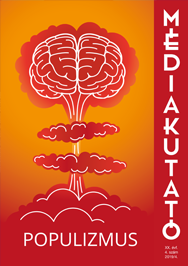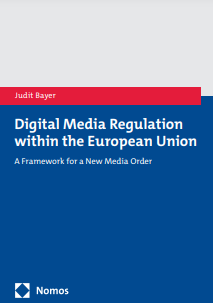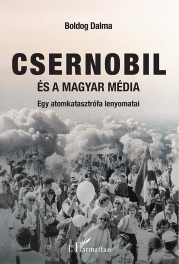Contents – Winter 2019
Pólya, Tamás:
Pólya, Tamás:
Can the divisive rhetoric of authoritarian political leaders be overcome? An evolutionary psychological analysis and proposals for a communication strategy Pt. I.
The popularity of authoritarian political leaders cannot be countered unless we understand the logic of their acceptance by their followers. The first part of this paper describes this logic in a multidisciplinary framework, based on three notions. First, that much of the popularity of authoritarian leaders seems to stem from their followers’ sense of being threatened (evolutionary psychology, sociology, political science). Second, that the neural substrates for one’s political beliefs and attitudes partly overlap with those for the ‘sacred,’ deeply held beliefs that are constitutive of one’s identity (such as their religious faith), so that it is very difficult to change these beliefs by offering educative facts or information to the believers that are different from their own views, as the attempted change triggers a strong resistance by the neural and psychological mechanisms developed for safeguarding the subjects’ identity (neuroscience, sociology of religion). Third, when an individual is facing political views opposing his or her own views, s/he will react at the neural level as if s/he had encountered a threatening environmental stimulus (neuroscience). The question then is, how can one’s political beliefs and convictions be possibly altered if they react to opposing political views as if being threatened both physically and in their identity? What are the limits of, and chances for, intelligent political discussion if our evolutionarily shaped proclivities act so efficiently against attempted belief-change? This paper (and its follow-up, see Pólya 2020) offers some basic recommendations for a communication strategy that might be deployed against authoritarian leaders and their deeply divisive rhetoric.
Keywords: individual and group identity, threatening stimuli and the perception of threat, the neural substrate of political attitudes, authoritarian leavers and their followers, the hostile and divisive chetoric of conflict, political communication, evolutionary psychology
Médiakutató Winter 2019 pp. 7-18
Kékesdi-Boldog, Dalma:
Kékesdi-Boldog, Dalma:
How Hungarian radio and Radio Free Europe communicated the Chernobyl nuclear disaster. A comparative analysis
On 26 of April 1986 1:23 AM a fatal nuclear accident occurred in the Soviet Union. Reactor No. 4 of the Vladimir Ilyich Lenin Nuclear Power Plant exploded, and harmful radioactive fall-out effused. The accident threatened most of the population of the Eastern Block, but the people – including those in Hungary – could not receive appropriate information about the threat because of the Cold War context and authoritarian media policy. Based on archival sources, this paper explores how the Chernobyl case was managed on Hungarian Radio an the Hungarian broadcasts of Radio Free Europe. It focuses on what was aired about the Hungarian nuclear radiation level and what health protection recommendations were issued in Hungary.
Keywords: Chernobyl disaster, Hungarian information policy, Hungarian Radio, Radio Free Europe, soviet/ communist media system
Médiakutató Winter 2019 pp. 21-35
Boros, Ulrika:
Boros, Ulrika:
The Golden Age of Hungarian Radio
This paper studies “Women’s Advisory,” a weekly magazine on Hungarian Radio broadcast between 1925 and 1945, addressing women, and hosted by Mária Arányi. It assesses the nature, structure and reception of this series on the basis of the texts and documents that are still available, and attempts to answer the question of how the anchor’s notion of womanhood relates to changes in gender and social roles during the post-war years. Does the broadcast reflect upon the emergence and spread of ‘modern ideas,’ including new female roles? Is it compatible with women’s duties and behaviour patterns that were considered traditional and acceptable during the Horthy era?
Keywords: Mária Arányi, “Women’s Advisory,” School of Happiness, association work, Horthy era, Hungarian Radio, “What’s the Message of Radio,” women’s magazine, women’s roles, concept of womanhood, women’s history, Radio Life, history of the radio, series
The Golden Age of Hungarian Radio
Médiakutató Winter 2019 pp. 37-49
Wirágh, András:
Wirágh, András:
Meshlike Hungarian literature at the fin-de-siècle
The lithographs (practically printed news suppliers or news-agencies) Általános Tudósító (General Reporter) and Munkatárs (Colleague), founded by Gyula Leopold in 1896 and 1902, respectively, were not sold to ordinary readers; only rural editorial newsrooms could subscribe. These special newspapers always contained (and distributed) literature. Feuilletons of certain authors were published in hundreds of rural newspapers, owing to Leopold’s great business idea and to the scarcity of texts, albeit editors and even typesetters could and did modify the texts. Leopold’s distribution networks may have taken charge of literary content of approx. 200 rural newspapers at the end of the first decade of the 20th century. Economic considerations (i. e. advertising) slowly overran aesthetic tasks (i. e. publishing A-category texts), hence the literature distributed by Munkatárs had a much smaller network than Általános Tudósító. This paper provides an insight into the connection between rural newsrooms and Leopold’s text-agencies as well as into the circumstances of distribution through an analysis of publication patterns of mass-distributed short stories.
Keywords: fin-de-siècle, republication, text-distribution network, literary agency, Gyula Leopold, László Cholnoky, István Szomaházy, unstable text, automatic distribution, rural press
Meshlike Hungarian literature at the fin-de-siècle
Médiakutató Winter 2019 pp. 51-61
Falyuna, Nóra:
Falyuna, Nóra:
A case study on the discourses of flat earth believers’ online community
The Web 2.0 has fundamentally changed the nature of the public sphere and the construction of reality, as well as the behaviour of communication actors. It has also had an effect on how both scientific and seemingly scientific but in fact invalid and non-credible contents appear and then spread very rapidly on the internet. This paper presents a case study of the Flat Earth Believers by analysing the discourse of a Hungarian Facebook group. The Flat Earth Believers disseminate a scientifically refuted and rejected theory, and are therefore a good example of online participatory culture: they cultivate their own, alternative “science” on the internet. The research asks the questions of what lingual, rhetorical and other discursive tools are involved in constructing the identity of this group. The analysis focuses on two elements of their identity construction: how they oppose other groups, and how they create their own scientific credibility. Based on these, the paper investigates 1) how polarisation plays a role in the construction of their identity and their credibility; and 2) how they use elements of scientific communication in their discourse. The investigation shows that in the group’s discourse, anti-scientific attitude is equally representative to the recognition of the authority, credibility and reliability of science they themselves wish to possess. The aim of this research is to draw attention to the need for new approaches in science communication in a changing world ever more defined by information technology and the internet, and to demonstrate that online communication may provide new contexts for studying the public understanding of science (PUS).
Keywords: conspiracy theory, critical skills, digital communication, digital and media competence, media awareness, participatory culture, pseudo-science, public understanding of science, science communication, social media
A case study on the discourses of flat earth believers’ online community
Médiakutató Winter 2019 pp. 65-82




